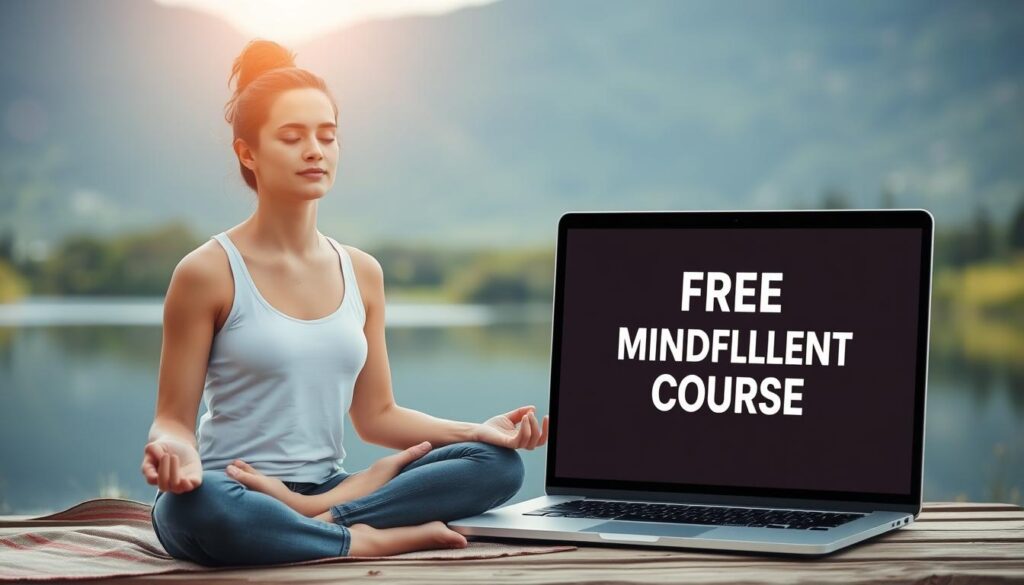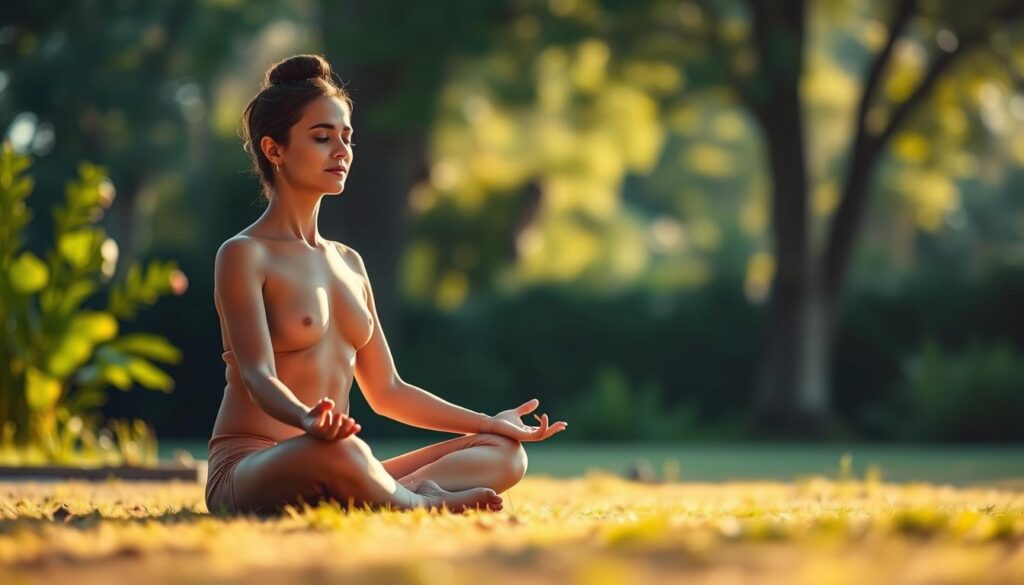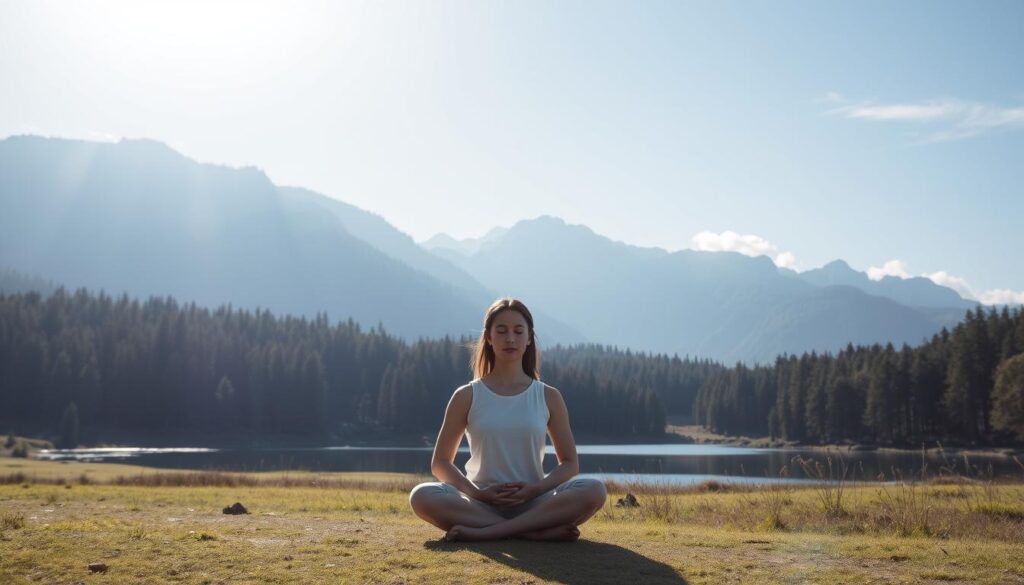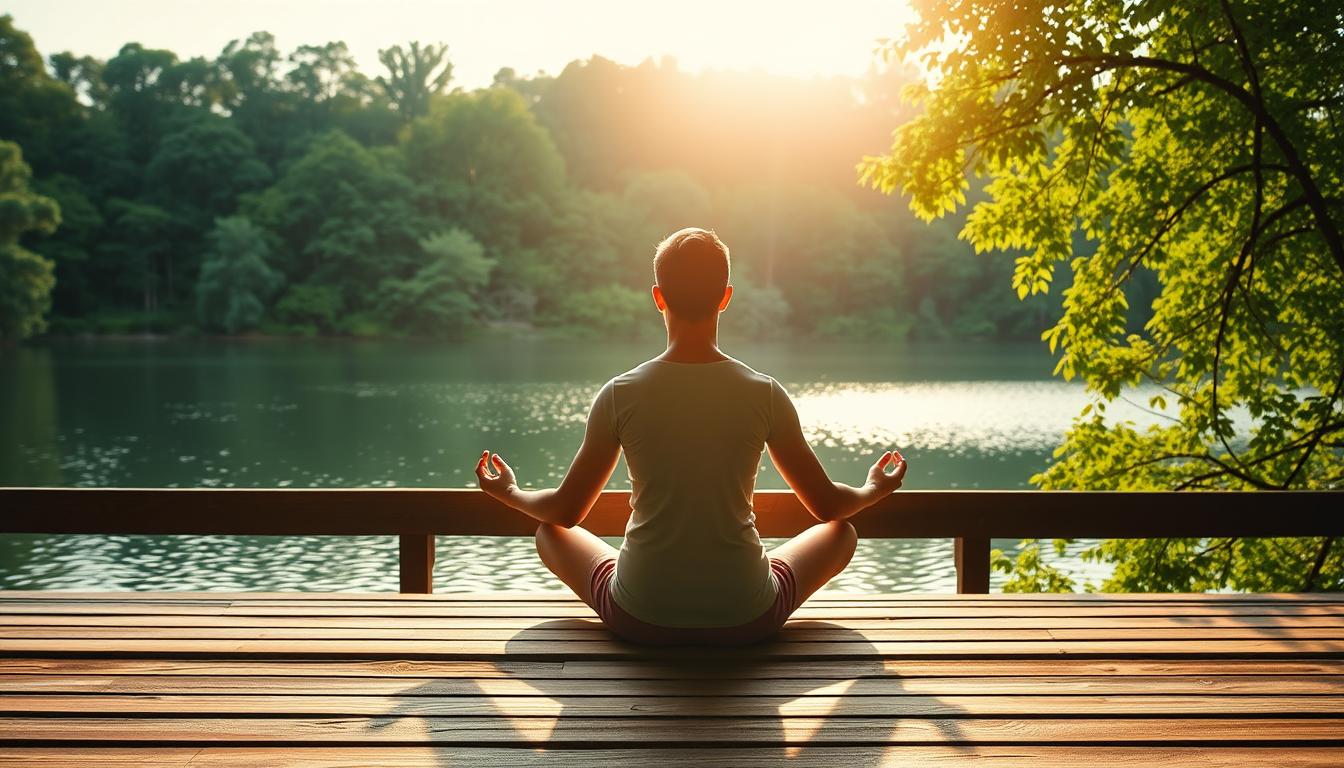I still remember the days when I thought meditation was something you had to do in a secluded monastery or a pricey wellness center – it felt like a luxury, not something for everyday life. But what if I told you that you can bring that feeling of calm into your daily life, for free, and from the comfort of your own home?
As we navigate the chaos of modern life, mindfulness has emerged as a powerful tool to combat stress and improve our mental wellbeing. The good news is that you don’t have to break the bank or attend in-person classes to start practicing meditation – there are numerous free online resources available.
Throughout this guide, we’ll explore the world of free online meditation resources, including MBSR courses, and other practices that can help you cultivate mindfulness in your daily life – even if you’re new to meditation.
Key Takeaways
- Discover the most accessible free online meditation resources
- Understand how mindfulness can help reduce stress
- Learn how to incorporate meditation into your daily routine
- Explore the benefits of MBSR courses
- Get started with simple, practical mindfulness practices
What is Mindfulness Meditation?
Let’s dive into the world of mindfulness meditation and explore what it’s all about. Mindfulness meditation is apracticethat involves being fully present and aware of our current experience, without judgment or reactivity. It’s about cultivatingattentionto the present moment, allowing us to respond to life’s challenges more mindfully.
The Essence of Mindfulness
At its core,mindfulnessis a basic human ability to be fully present and aware. It’s not something we need to acquire; rather, it’s a quality we already possess that can be developed through regularmeditationpractice. By being more mindful, we can approach life’s situations with greater clarity and kindness.
Difference Between Mindfulness and Meditation
While often used interchangeably,mindfulnessandmeditationhave distinct meanings. Mindfulness refers to the quality of awareness we bring to our experiences, whereas meditation is a formalpracticethat cultivates this awareness. In essence, meditation is a way to develop mindfulness, allowing us to be more present and aware in our daily lives. By understanding the difference, we can better appreciate the value of incorporating mindfulnessmeditationinto our daily routine.
Benefits of Regular Mindfulness Practice
The benefits of mindfulness practice are numerous and backed by scientific research. By incorporating mindfulness into your daily routine, you can experience a wide range of positive changes in both your physical and mental health. Mindfulness practice has been shown to have a positive impact on various aspects of life, from reducing stress and anxiety to improving focus and overall wellbeing.
Physical Health Benefits
Regular mindfulness practice has been linked to several physical health benefits, including reduced blood pressure, improved immune function, and better sleep quality. By reducing stress, mindfulness practice can help mitigate the negative impact of stress on the body, leading to overall better health.
Mental and Emotional Wellbeing
Mindfulness practice is also beneficial for mental and emotional wellbeing. It helps in reducing symptoms of anxiety and depression by breaking the cycle of rumination and worry. Moreover, mindfulness enhances emotional regulation, allowing for a more balanced and resilient response to life’s challenges.
Improved Focus and Productivity
Another significant benefit of mindfulness practice is its ability to improve focus and productivity. By training your attention, mindfulness helps in reducing mental clutter and enhancing concentration, leading to greater efficiency in work and daily activities.
Free Mindfulness Training Resources Online

You don’t have to break the bank to start your mindfulness journey. There are numerous free mindfulness training resources available online that can help you get started.
Palouse Mindfulness MBSR Course
The Palouse Mindfulness MBSR Course is a fully certified, 100% free online course based on the program founded by Jon Kabat-Zinn at the University of Massachusetts Medical School. This comprehensive course offers the complete 8-week Mindfulness-Based Stress Reduction (MBSR) curriculum with no hidden fees or email requirements.
University-Affiliated Free Programs
Many universities, such as UCLA and Brown, offer free guided meditations, videos, and resources created by leading mindfulness researchers. These programs are a great way to access high-quality mindfulness materials.
Mobile Apps Offering Free Meditation
Popular mobile apps like Insight Timer offer thousands of free guided meditations from various teachers. These apps make it easy to practice mindfulness on-the-go.
With these resources, you can explore different aspects of mindfulness and find what works best for you. Whether you’re a beginner or looking to deepen your practice, there’s something available for everyone.
Getting Started with Basic Meditation Techniques
Meditation is a journey, not a destination, and it begins with straightforward techniques that help you cultivate mindfulness. To start meditating, you need to set aside some time and create a conducive environment.
Creating Your Meditation Space
I’ll walk you through creating a simple meditation space that works for your real life. You don’t need fancy cushions or incense; just a quiet spot where you can sit undisturbed. This space will help you establish a consistent meditation practice.
Proper Posture and Breathing
Let’s explore comfortable meditation postures that work for regular people with regular bodies. You can sit in chairs or even lie down if needed. The key is to be comfortable so you can focus on your breath. Proper posture and breathing techniques are essential for a fruitful meditation session.
Setting Realistic Expectations
You’ll learn how to set realistic expectations for your practice. A “successful” meditation isn’t one without thoughts but one where you notice when you’re distracted. Being kind to your wandering mind is crucial. Don’t judge yourself for whatever thoughts crop up; just practice recognizing when your mind has wandered off, and gently bring it back.
To make meditation a habit, start with just a few minutes each day. Consistency is more important than the duration of your meditation sessions. By incorporating these basic techniques into your daily routine, you’ll be well on your way to developing a sustainable meditation practice.
Core Mindfulness Practices You Can Try Today
Let’s explore some core mindfulness practices that you can start using today to bring more clarity and calm into your life. These practices are simple, yet powerful, and can be adapted to fit into your daily routine.
These core practices are foundational to most meditation traditions and can be used in various contexts to help you stay mindful.
Focused Attention Meditation
Focused attention meditation is a practice that involves focusing your attention on a specific object, in this case, your breath. It is not because the breath is special, but because it is always present and provides a concrete point of focus. When your mind wanders, gently bring it back to the breath. This practice helps build concentration and reduce mind-wandering.
Body Scan Meditation

Body scan meditation is a practice that helps you reconnect with your physical body and release tension. Lie down or sit comfortably, and bring your attention to different parts of your body, starting from your toes and moving up to the top of your head. As you focus on each area, notice any sensations, tension, or relaxation. This practice can help you cultivate mindfulness and relaxation.
Mindful Movement Practices
Mindful movement practices, such as gentle yoga or walking meditation, can help you integrate mindfulness into your daily activities. By focusing on the breath while performing simple movements, you can synchronize your mind and body. This practice can help you stay calm and clear, even in the midst of busy activities.
These practices complement each other well: the body scan helps with physical awareness, focused attention builds concentration, and mindful movement connects the mind and body. You can adapt these practices to different situations, such as using brief focused attention during a stressful workday or a body scan to help with sleep.
Incorporating Mindfulness Into Daily Life
We can practice mindfulness in many ways, from simple actions like eating and walking to more formal meditation practices. This practice can be seamlessly integrated into our daily routines, making it a part of our everyday experience.
As we go about our day, we can turn ordinary activities into opportunities for mindfulness practice. For instance, we can practice mindful eating by savoring each bite, paying attention to the flavors, textures, and smells of our food. This can help us slow down and enjoy our meals more, potentially improving digestion and reducing mindless overeating.
Mindful Eating and Walking
When we eat, we can focus on the experience, noting the colors, smells, and tastes of our food. Similarly, when we walk, we can be mindful of our steps, the sensation of our feet touching the ground, and the rhythm of our breath. This simple practice can turn our daily walks into moments of presence and relaxation.
Brief Mindfulness Breaks During Work
Taking short breaks throughout the day can help us stay focused and reduce stress. A simple “three breath break” can be taken in less than 30 seconds, yet it can reset our mental state and improve our productivity. We can also use everyday triggers like phone notifications or red lights as reminders to take a few deep breaths and bring our attention to the present moment.
Evening Wind-Down Practices
As we transition from work mode to relaxation, we can use mindfulness practices to help us unwind. A 20-minute bedtime practice, for example, can help us stay settled and less caught up in our thoughts as we fall asleep. This can be done by combining breath awareness, body scan, and mindfulness of thoughts to explore sources of stress and anxiety.
By incorporating these simple mindfulness practices into our daily lives, we can experience numerous benefits, from reduced stress and anxiety to improved focus and overall well-being. As we make mindfulness a part of our daily routine, we can find that it becomes a valuable tool for navigating the challenges of everyday life.
The Science Behind Mindfulness Training Free
By understanding the science behind mindfulness, we can better appreciate its benefits for our overall well-being. Mindfulness isn’t just a practice; it’s backed by research that shows its positive impact on both body and mind. Jon Kabat-Zinn, the creator of the Mindfulness-Based Stress Reduction (MBSR) program, has been at the forefront of this research.

Neuroplasticity and Brain Changes
Research has shown that regular mindfulness practice can lead to significant changes in the brain. Studies using brain imaging techniques have found that mindfulness practice can increase gray matter in areas associated with self-awareness, compassion, and memory. This is a result of neuroplasticity, the brain’s ability to change and adapt in response to new experiences.
Research on Stress Reduction
Mindfulness has been shown to have a positive impact on stress reduction. According to a study published on the PMC, mindfulness training can affect stress hormones like cortisol, potentially reducing inflammation and improving immune function. By reducing the activity in the amygdala, our brain’s alarm system, mindfulness helps us respond to stressful situations more mindfully.
- Mindfulness practice can lead to changes in the brain’s structure and function.
- Regular mindfulness practice has been shown to reduce stress and anxiety.
- The benefits of mindfulness are backed by a growing body of research.
Overcoming Common Meditation Challenges
The journey of meditation is not without its challenges, but understanding these can help us navigate them. Many people think they’re messing up when they’re meditating because of how busy their mind is. However, getting lost in thought, noticing it, and returning to your chosen meditation object is actually how meditation is practiced.
Let’s look at some common challenges and how to overcome them.
Dealing with a Wandering Mind
One of the most common challenges is dealing with a wandering mind. Instead of fighting it, we can use it as an opportunity to practice mindfulness. When we notice our mind wandering, we bring it back to our chosen object, like our breath or a body sensation. This process, repeated many times, is actually the practice itself.
Finding Time to Practice
Finding time to meditate can be challenging, but “habit stacking” can help. This involves attaching meditation to an existing routine, like right after waking up or before a meal. Using transition times like during a commute or while waiting in line can also be beneficial.
Measuring Progress in Meditation
Measuring progress can be difficult since the benefits of meditation are often subtle. Instead of looking for specific outcomes, we can note changes in our daily life, like feeling more calm or being more focused. Keeping a meditation journal can also help track our progress over time.
As the meditation instructor, Jon Kabat-Zinn, once said,
“You can’t force it, you have to let it happen, and when you realize that, then you are in a different relationship to your practice, to your meditation, to your life.”
This quotation highlight the importance of being patient and open to the process.
Some key questions to consider when looking for a meditation instructor include:
- Do you have good chemistry with them?
- Are they open and accessible?
- Do they have a deep understanding of the practice?
- Could they regard you like a friend?
Let’s summarize some key aspects of overcoming challenges in a simple table:
| Challenge | Solution |
|---|---|
| Wandering mind | Use it as an opportunity to practice mindfulness |
| Finding time | Use “habit stacking” and utilize transition times |
| Measuring progress | Note changes in daily life and keep a meditation journal |
Conclusion: Beginning Your Mindfulness Journey
As we wrap up our exploration of free online mindfulness resources, it’s clear that the path to a more mindful life is more accessible than ever. We’ve covered various free online mindfulness courses and meditation practice materials, including those from the University of Massachusetts’s MBSR program.
To start your mindfulness journey, explore the resources mentioned, such as guided meditation and body scan exercises. Remember, mindfulness is a skill that develops gradually – it’s not about achieving perfection but about making progress.
Begin with simple curiosity, and let your practice unfold naturally. With consistent effort, you’ll experience stress reduction and other benefits that enhance your overall well-being.
FAQ
What is Mindfulness-Based Stress Reduction (MBSR)?
MBSR is a program developed by Jon Kabat-Zinn that combines meditation, yoga, and education to help people manage stress and improve their overall well-being. It’s a powerful tool for reducing anxiety and cultivating a sense of calm in daily life.
How do I start a meditation practice?
To begin meditating, find a quiet space, sit comfortably, and focus on your breath. You can start with short sessions, like 5-10 minutes, and gradually increase the duration as you become more comfortable with the practice. Using guided meditations can also be helpful.
What are the benefits of regular meditation?
Regular meditation can lead to a range of benefits, including reduced stress, improved focus, and enhanced emotional well-being. It can also help you develop greater self-awareness and improve your overall quality of life.
Can I practice mindfulness without meditating?
Yes, you can incorporate mindful movement and other mindfulness practices into your daily activities, such as eating, walking, or even doing chores. This can help you cultivate a greater sense of awareness and presence in your daily life.
How can I stay motivated to practice meditation regularly?
To stay motivated, try setting aside a specific time each day to meditate, and use guided meditations or meditation apps to help you stay on track. You can also join a meditation community or find a meditation buddy for support.
What is the difference between mindfulness and meditation?
While often used together, meditation is a specific practice where you focus your attention, whereas mindfulness is a broader practice of being present and aware in daily life. Meditation can be a powerful tool for cultivating mindfulness.
Can mindfulness help with stress reduction?
Yes, stress reduction is one of the most well-documented benefits of mindfulness practice. By cultivating greater awareness and calm, you can better manage stress and improve your overall well-being.
